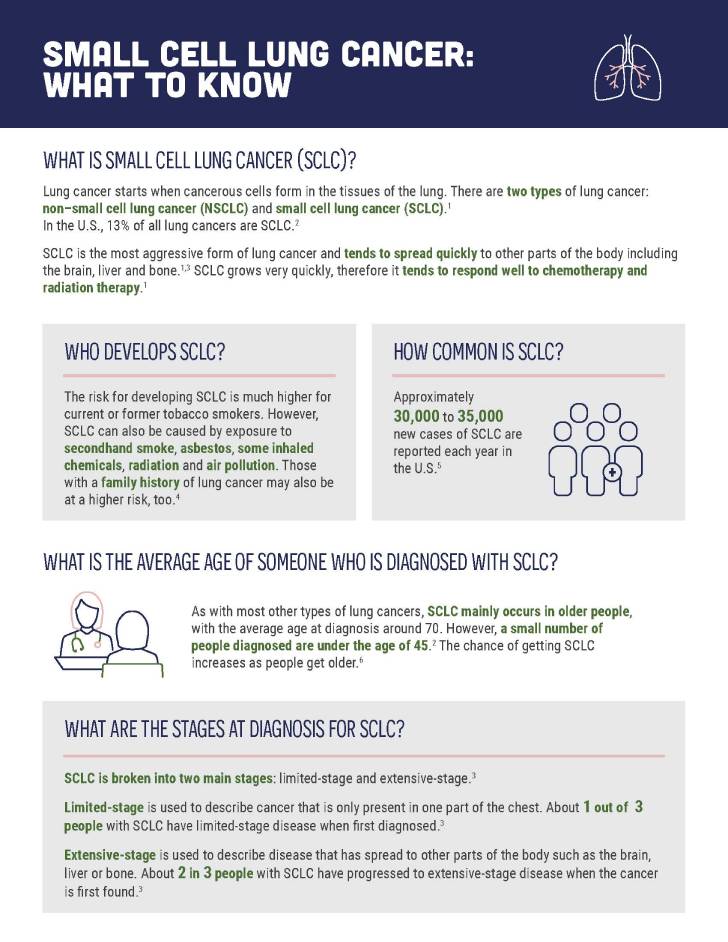Small Cell Lung Cancer: What to Know
What is Small Cell Lung Cancer (SCLC)?
Lung cancer starts when cancerous cells form in the tissues of the lung. There are two types of lung cancer: non–small cell lung cancer (NSCLC) and small cell lung cancer (SCLC).1 In the U.S., 13% of all lung cancers are SCLC.2
SCLC is the most aggressive form of lung cancer and tends to spread quickly to other parts of the body including the brain, liver and bone.1,3 SCLC grows very quickly, therefore it tends to respond well to chemotherapy and radiation therapy.1
Who develops SCLC?
The risk for developing SCLC is much higher for current or former tobacco smokers. However, SCLC can also be caused by exposure to secondhand smoke, asbestos, some inhaled chemicals, radiation and air pollution. Those with a family history of lung cancer may also be at a higher risk, too.4
How common is SCLC?
Approximately 30,000 to 35,000 new cases of SCLC are reported each year in the U.S.5
What is the average age of someone who is diagnosed with SCLC?
As with most other types of lung cancers, SCLC mainly occurs in older people, with the average age at diagnosis around 70. However, a small number of people diagnosed are under the age of 45.2 The chance of getting SCLC increases as people get older.6
What are the stages at diagnosis for SCLC?
SCLC is broken into two main stages: limited-stage and extensive-stage.3
Limited-stage is used to describe cancer that is only present in one part of the chest. About 1 out of 3 people with SCLC have limited-stage disease when first diagnosed.3
Extensive-stage is used to describe disease that has spread to other parts of the body such as the brain, liver or bone. About 2 in 3 people with SCLC have progressed to extensive-stage disease when the cancer is first found.3
What are common symptoms of SCLC?
Symptoms of SCLC include unexplained weight loss, chest pain, shortness of breath, swelling of the neck or face, and coughing up phlegm, mucus or blood.7
Is there a cure?
There is no cure for SCLC, but there are several therapies available to treat it, either alone or in combination.6
What are some of the treatments for SCLC?
People with SCLC are treated with different combinations of chemotherapy drugs, radiation therapy and immunotherapy. People might also have the option to undergo a new treatment that is being studied in a clinical trial.6
The stage of cancer is a key decision factor in the therapy a doctor selects. Limited-stage SCLC is often treated with chemotherapy, either alone or combined with radiation therapy.6
Extensive-stage SCLC is typically treated initially with combination chemotherapy; this may be combined with an immunotherapy if that approach is recommended by a doctor. Some doctors may also recommend radiation therapy to parts of the body where cancer has spread, or palliative therapy to ease symptoms.6
A large percentage of patients on treatment regimens briefly achieve a response, although the cancer often returns.5
What steps can I take to reduce the risk of developing SCLC?
Refraining from using tobacco products, such as cigarettes, cigars or pipe tobacco – in addition to reducing any exposure to harmful chemicals – are all steps that can be taken to avoid lung cancer risk factors.4 Knowing if there is a history of cancer in your family is also important.4
- American Cancer Society. What is lung cancer? https://www.cancer.org/cancer/lung-cancer/about/what-is.html. Updated October 1, 2019. Accessed March 28, 2025.
- American Cancer Society. Key statistics for lung cancer. https://www.cancer.org/cancer/lung-cancer/about/key-statistics.html. Updated January 12, 2021. Accessed March 28, 2025.
- American Cancer Society. Small cell lung cancer stages. https://www.cancer.org/cancer/lung-cancer/detection-diagnosis-staging/staging-sclc.html. Updated October 1, 2019. Accessed
March 28, 2025. - American Cancer Society. Small cell lung cancer causes, risk factors, and prevention. https://www.cancer.org/content/dam/CRC/PDF/Public/8709.00.pdf. Updated May 16, 2016. Accessed
March 28, 2025. - National Organization for Rare Diseases. Small cell lung cancer. https://rarediseases.org/rare-diseases/small-cell-lung-cancer/. Updated 2019. Accessed March 28, 2025.
- National Cancer Institute. Small cell lung cancer treatment (patient version) https://www.cancer.gov/types/lung/patient/small-cell-lung-treatment-pdq. Updated May 7, 2021. Accessed March 28, 2025.
- Cancer.Net. Lung cancer – small cell: Symptoms and signs. https://www.cancer.net/cancer-types/lung-cancer-small-cell/symptoms-and-signs. Updated July 2019. Accessed March 28, 2025.

